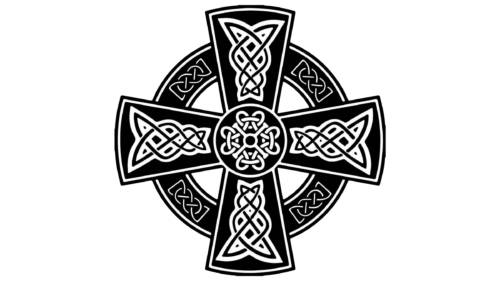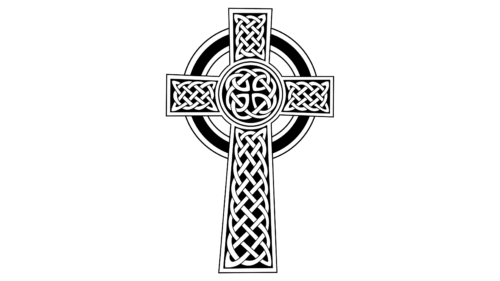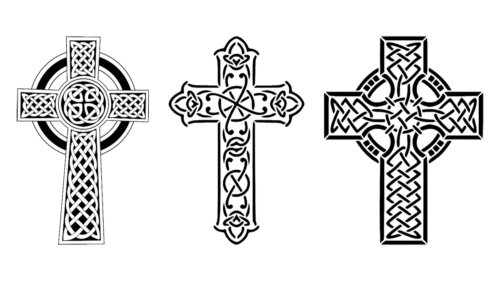The enigma of Celtic symbols extends beyond the iconic Celtic cross, encompassing a vast array of emblems each with its own profound meaning and history. Celtic symbols are a conduit to a time when these signs were a language unto themselves, a visual shorthand for the values, myths, and natural phenomena deemed pivotal by the ancient Celts.
These symbols often reflect the Celts’ deep respect for the natural world, their belief in the interconnectedness of all life, and their understanding of the cycles of existence. They adorned their most sacred objects like the Claddagh ring, which represents love, loyalty, and friendship, and the Dara Knot, symbolizing the root system of an oak tree, which the Celts held as a sacred symbol of strength. Moreover, the Spiral, found on megalithic tombs and ancient manuscripts, represents the concept of growth, expansion, and cosmic energy, mirroring the Celts’ belief in the progression of life and the seasons. Another symbol, the Triskelion, with its three spirals, speaks of motion, cycles, progress, and competition.
Celtic symbols have transcended their original contexts to become emblems of a broader cultural identity. They serve as a connection to the Celtic ancestry for many around the world, embodying the wisdom and traditions of an ancient civilization that revered the arts, nature, and the metaphysical. Even in modern times, these Celtic symbols are laden with the power of the old ways, imbuing objects and artworks with layers of meaning and connecting the present with the mystical past.
The Celtic cross is a symbol that resonates with a myriad of meanings, each interwoven with the threads of history, spirituality, and artistry that define the Celtic culture. To explore the Celtic cross is to delve into a rich tapestry of tradition that has survived and evolved through centuries.
The cross’s design is instantly recognizable: the cross itself represents Christianity, a faith that spread through Celtic lands in the early medieval period. The circle that envelops the intersection is believed to signify unity, wholeness, and the eternal cycle of life — a nod to older, pre-Christian beliefs. This combination of cross and circle is a harmonious blend of the Celtic reverence for nature and their embrace of the Christian faith.
Let’s delve deeper into the various facets of the Celtic cross:
- Symbolism: The cross’s symbolism extends beyond the mere fusion of a circle and a cross. Each arm of the cross and the circle are often adorned with intricate knotwork or insular art, which is characteristic of the early medieval art of the British Isles.
- Use in Monuments: Historically, large Celtic crosses served as public monuments. The high crosses found in Ireland, Scotland, and Wales often functioned as meeting points for religious ceremonies and public gatherings.
- Cultural Identity: In contemporary times, the Celtic cross has become a symbol of Celtic identity, reflecting a sense of belonging and a connection to the ancestors who once populated the Celtic lands.
- Art and Architecture: Celtic crosses have had a profound influence on art and architecture. Their design has been incorporated into the stonework of ancient churches and cathedrals, and they continue to inspire modern artists and architects.
Here are some more detailed points on the Celtic cross:
- Historical Context: The earliest examples of the Celtic cross date from the 9th century and are found in Ireland. As Christianity took root in the Celtic nations, the cross emerged as a symbol of faith and cultural identity.
- Geographic Spread: While the Celtic cross is commonly associated with Ireland, its presence is found throughout the British Isles, with variations in design reflecting the local culture and artistic tradition.
- Modern Usage: Today, the Celtic cross is used in jewelry, tattoos, clothing designs, and even in popular media, symbolizing a connection to the Celtic heritage. It’s also a prominent symbol in graveyards, where it stands as a sentinel over the deceased, offering protection and representing the passage to the afterlife.
An interesting fact about the Celtic cross is its connection to astronomy. Some historians and archaeologists suggest that the cross’s circle may have functioned as an astronomical feature, aligning with the sun during solstices, which was significant for the agrarian Celtic society.
A poignant quote related to the Celtic cross comes from the Irish poet W.B. Yeats, who was deeply influenced by Celtic mythology and symbolism:
“The Celtic, like all those who are truly spiritual, walks with the shadowy semblance of things behind him and the bright reality before him.”
Yeats’ words echo the profound spiritual and philosophical undertones of the Celtic cross, capturing the essence of what this symbol has represented for the Celts: a beacon guiding them towards the ethereal light of understanding, a light that transcends the mere physicality of existence.
In essence, the Celtic cross is not just a symbol from the past; it is a living part of Celtic heritage. It represents a worldview where the spiritual and material realms are intricately linked, and where the echoes of the ancestors are heard in the winds that cross the moors and in the stones of ancient ruins. Its power lies in its universality – as a symbol of faith, as an emblem of heritage, and as a piece of cultural art that continues to inspire awe and reverence.
Celtic Cross Tattoo
The Celtic cross has made a profound impact on the world of body art, with the tattoo form of this ancient symbol becoming a powerful way for individuals to express their identity, beliefs, and connections to heritage. Celtic cross tattoos are particularly popular among those of Celtic descent or those who resonate with the culture’s rich history and symbolism. But their appeal is not limited by ethnicity or religion; many are drawn to the Celtic cross for its intricate design and the values it represents.
A Celtic cross tattoo is more than just a piece of art; it’s a personal emblem of one’s spirituality or a tribute to ancestral roots. It can serve as a visual affirmation of faith, a reminder of the timeless nature of the soul, and the interconnectedness of all things. The knotwork that adorns the cross is often customized to include personal symbols or to emphasize certain aspects of the wearer’s life and beliefs. Each twist and turn in the design can represent life’s complex journey, with the central cross providing an anchor and the circle symbolizing the continuity and cyclicity of existence.
For many, choosing to wear a Celtic cross tattoo is a decision imbued with introspection and meaning. It can be a declaration of one’s philosophy, an artistic representation of life’s interwoven paths, or a sacred talisman to ward off harm. The placement of the tattoo is also significant and is often chosen with intention — over the heart, on a limb that has faced challenge or injury, or on the back as a metaphorical “shield” in life.
In the modern tattoo culture, the Celtic cross is a versatile symbol, adaptable and deeply personal. Whether etched in black and white to highlight the contrast and complexity of its design, or infused with color that adds another layer of meaning, each Celtic cross tattoo is as unique as the individual who bears it. It is a canvas of personal expression, a silent testament to the enduring legacy of Celtic art and spirituality.









